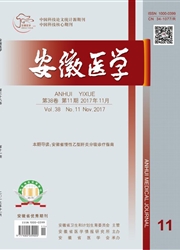

 中文摘要:
中文摘要:
目的探讨金黄色葡萄球菌感染的临床分布及耐药特点,为临床诊断和治疗提供依据。方法 109株金黄色葡萄球菌药敏试验采用琼脂稀释法,结果依据CLSI 2010年推荐的标准进行判读。结果金黄色葡萄球菌在呼吸道痰标本中检出率最高,达31.2%;主要分布于重症监护病房、骨科、儿科等;药敏结果显示,金黄色葡萄球菌对青霉素、氨苄西林、克林霉素、阿奇霉素和红霉素高度耐药,耐药率均高于90%;对头孢他啶耐药率达50%,对其他三四代头孢菌素耐药率在25%左右;对喹诺酮类抗菌药物耐药率较高,达40%;对氨基糖苷类中的阿米卡星敏感性高,敏感率达85.2%;利福平具有较高的敏感性,达84.0%;尚未发现对万古霉素、替考拉宁及利奈唑胺耐药的菌株。结论安徽地区金黄色葡萄球菌对多种抗菌药物耐药,临床应加强对金黄色葡萄球菌耐药性的监控并防止耐药菌株的传播流行。
 英文摘要:
英文摘要:
Objective To analyze the clinical distribution and antimierobial resistance of Staphylococcus aureus (S. aureus) in order to provide the scientific evidence for clinical diagnosis and treatment. Methods The antimicrobial susceptibility test to 109 strains of S. aureus was performed by agar dilution method. The results were judged according to the criteria recommended by Clinical and Laboratory Standards In- stitute (CLSI) 2010. Results The majority of S. aureus were isolated from the specimen of sputum, accounting for 31.2%. The bacteria was frequently distributed in Intensive Care Unit, followed by Department of Orthopedics, Department of Pediatrics. The results of antimierobial sus- ceptibility test showed that S. aureus was highly resistant to penicillin, ampicillin, elindamycin, azithromycin and erythromycin, but sensitive to amikacin and rifampicin. The resistance rate to ceftazidime was 50%, but to the other third and fourth generation cephalosporins were about 25%. The resistance rates to quinolones were high, about 40%. No strain which was resistant to vancomycin, teicoplanin and linezolid was iso- lated. Conclusion S. aureus is resistant to many kinds of antimicrobial agents. The surveillance of antimierobial resistance in S. aureus should be strengthened for purpose of preventing the transmission of muhidrug resistant strains.
 同期刊论文项目
同期刊论文项目
 同项目期刊论文
同项目期刊论文
 Prevalence of plasmid-mediated quinolone resistance determinants in association withb-lactamases, 16
Prevalence of plasmid-mediated quinolone resistance determinants in association withb-lactamases, 16 Stenotrophomonas maltophilia resistance to trimethoprim/ sulfamethoxazole mediated by acquisition of
Stenotrophomonas maltophilia resistance to trimethoprim/ sulfamethoxazole mediated by acquisition of Detection of the plasmid-mediated quinolone resistance determinants and the emergence of multidrug r
Detection of the plasmid-mediated quinolone resistance determinants and the emergence of multidrug r Surveillance of Antimicrobial Susceptibility Patterns among Shigella 5 Species Isolated in China dur
Surveillance of Antimicrobial Susceptibility Patterns among Shigella 5 Species Isolated in China dur 期刊信息
期刊信息
